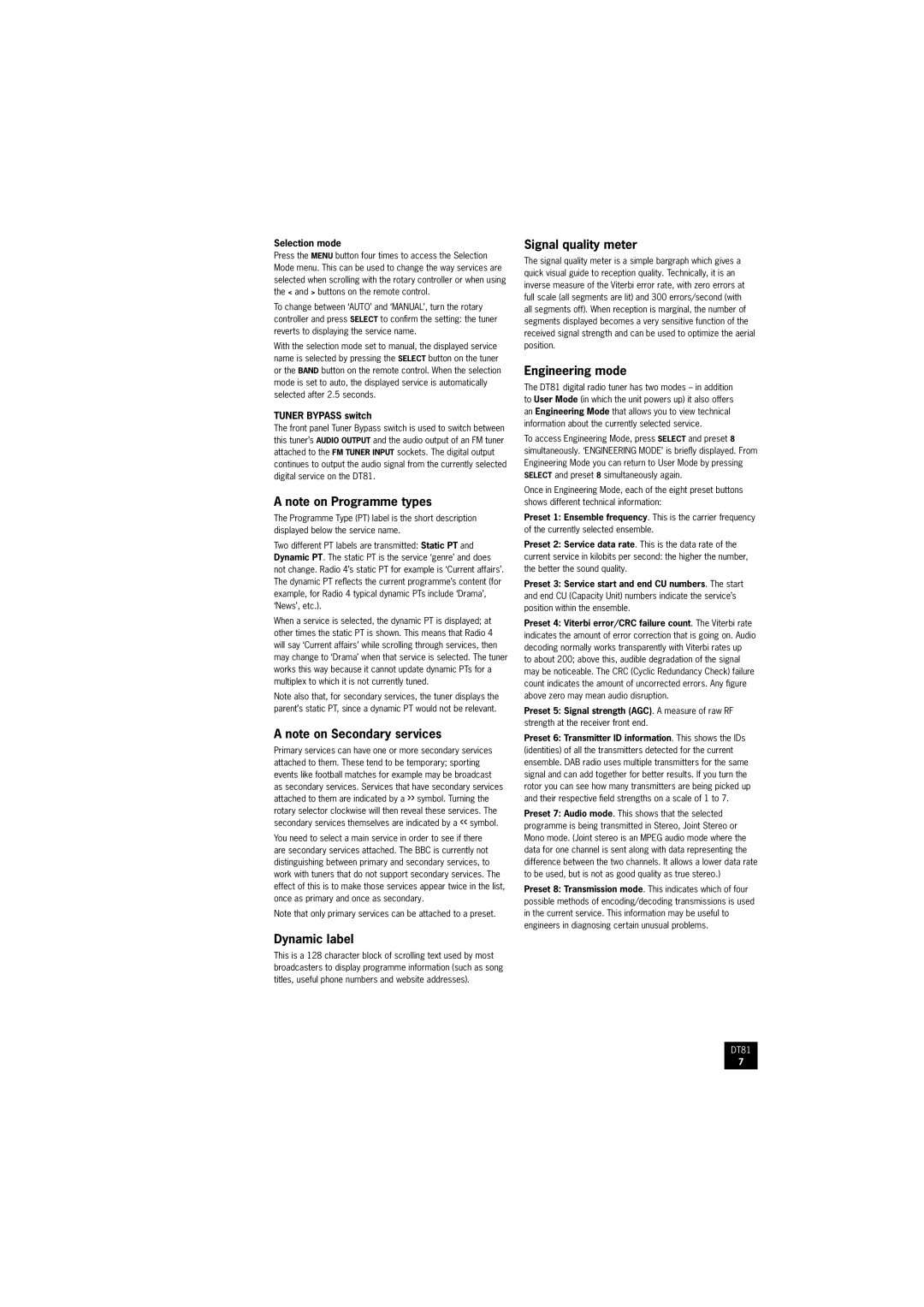Selection mode
Press the MENU button four times to access the Selection Mode menu. This can be used to change the way services are selected when scrolling with the rotary controller or when using the < and > buttons on the remote control.
To change between ‘AUTO’ and ‘MANUAL’, turn the rotary controller and press SELECT to confirm the setting: the tuner reverts to displaying the service name.
With the selection mode set to manual, the displayed service name is selected by pressing the SELECT button on the tuner or the BAND button on the remote control. When the selection mode is set to auto, the displayed service is automatically selected after 2.5 seconds.
TUNER BYPASS switch
The front panel Tuner Bypass switch is used to switch between this tuner’s AUDIO OUTPUT and the audio output of an FM tuner attached to the FM TUNER INPUT sockets. The digital output continues to output the audio signal from the currently selected digital service on the DT81.
A note on Programme types
The Programme Type (PT) label is the short description displayed below the service name.
Two different PT labels are transmitted: Static PT and Dynamic PT. The static PT is the service ‘genre’ and does not change. Radio 4’s static PT for example is ‘Current affairs’. The dynamic PT reflects the current programme’s content (for example, for Radio 4 typical dynamic PTs include ‘Drama’, ‘News’, etc.).
When a service is selected, the dynamic PT is displayed; at other times the static PT is shown. This means that Radio 4 will say ‘Current affairs’ while scrolling through services, then may change to ‘Drama’ when that service is selected. The tuner works this way because it cannot update dynamic PTs for a multiplex to which it is not currently tuned.
Note also that, for secondary services, the tuner displays the parent’s static PT, since a dynamic PT would not be relevant.
A note on Secondary services
Primary services can have one or more secondary services attached to them. These tend to be temporary; sporting events like football matches for example may be broadcast as secondary services. Services that have secondary services attached to them are indicated by a >> symbol. Turning the rotary selector clockwise will then reveal these services. The secondary services themselves are indicated by a << symbol.
You need to select a main service in order to see if there are secondary services attached. The BBC is currently not distinguishing between primary and secondary services, to work with tuners that do not support secondary services. The effect of this is to make those services appear twice in the list, once as primary and once as secondary.
Note that only primary services can be attached to a preset.
Dynamic label
This is a 128 character block of scrolling text used by most broadcasters to display programme information (such as song titles, useful phone numbers and website addresses).
Signal quality meter
The signal quality meter is a simple bargraph which gives a quick visual guide to reception quality. Technically, it is an inverse measure of the Viterbi error rate, with zero errors at full scale (all segments are lit) and 300 errors/second (with all segments off). When reception is marginal, the number of segments displayed becomes a very sensitive function of the received signal strength and can be used to optimize the aerial position.
Engineering mode
The DT81 digital radio tuner has two modes – in addition to User Mode (in which the unit powers up) it also offers an Engineering Mode that allows you to view technical information about the currently selected service.
To access Engineering Mode, press SELECT and preset 8 simultaneously. ‘ENGINEERING MODE’ is briefly displayed. From Engineering Mode you can return to User Mode by pressing SELECT and preset 8 simultaneously again.
Once in Engineering Mode, each of the eight preset buttons shows different technical information:
Preset 1: Ensemble frequency. This is the carrier frequency of the currently selected ensemble.
Preset 2: Service data rate. This is the data rate of the
current service in kilobits per second: the higher the number, the better the sound quality.
Preset 3: Service start and end CU numbers. The start and end CU (Capacity Unit) numbers indicate the service’s position within the ensemble.
Preset 4: Viterbi error/CRC failure count. The Viterbi rate indicates the amount of error correction that is going on. Audio decoding normally works transparently with Viterbi rates up
to about 200; above this, audible degradation of the signal may be noticeable. The CRC (Cyclic Redundancy Check) failure count indicates the amount of uncorrected errors. Any figure above zero may mean audio disruption.
Preset 5: Signal strength (AGC). A measure of raw RF
strength at the receiver front end.
Preset 6: Transmitter ID information. This shows the IDs (identities) of all the transmitters detected for the current ensemble. DAB radio uses multiple transmitters for the same signal and can add together for better results. If you turn the rotor you can see how many transmitters are being picked up and their respective field strengths on a scale of 1 to 7.
Preset 7: Audio mode. This shows that the selected programme is being transmitted in Stereo, Joint Stereo or Mono mode. (Joint stereo is an MPEG audio mode where the data for one channel is sent along with data representing the difference between the two channels. It allows a lower data rate to be used, but is not as good quality as true stereo.)
Preset 8: Transmission mode. This indicates which of four possible methods of encoding/decoding transmissions is used in the current service. This information may be useful to engineers in diagnosing certain unusual problems.
DT81
